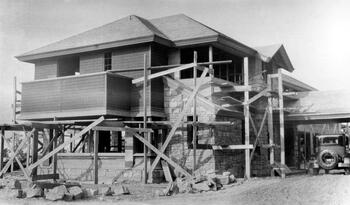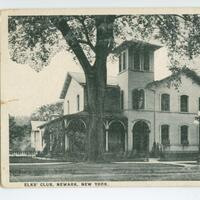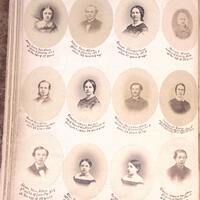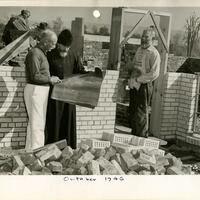This collection consists of photographs of the Darwin D. Martin family of Buffalo, NY, and photographs of homes designed by Frank Lloyd Wright for the Martins: the Darwin D. Martin House Complex in Buffalo and Graycliff in Derby, NY. The Darwin D. Martin Photograph Collection forms part of the Frank Lloyd Wright/Darwin D. Martin Collection in the University Archives and Special Collections and contains Martin family papers, correspondence between Wright and Martin, and architectural drawings. The images offer a representative sample of several people and structures that helped transform and define Buffalo as a nationally recognized industrial center in the late 19th century into the early 20th century. Buffalo, NY, from the end of the Civil War to the Great Depression, is perhaps one of the best representations of a region exhibiting the supreme tensions existing in America’s growing industrial urban areas: tensions between the push for modern advancement and the pull of traditional agrarian ideals of earlier American lifestyles. The life and times of the Darwin D. Martin family and their associates, including personalities such as Frank Lloyd Wright, present a microcosm of this contrast in American culture moving into the 20th century. Darwin Denice Martin was born in 1865 in Madison County, NY, to Hiram Martin and Anna Eliza McMannis. Darwin Martin’s mother died when he was just six years old. His father was a farmer who spent time in Iowa and Nebraska before finally settling in Buffalo in 1878. At the end of the Civil War, Buffalo was on its way to becoming a boom city. The railroads, as well as the Erie Canal, contributed to establishing the area as a central point in the exchange of raw materials coming from the west and heading to eastern factories and of finished products from those factories in the east heading out to consumers in the west. Buffalo itself was also a great manufacturing center along with the rail and shipping industries for transporting the enormous volume of raw materials and manufactured goods. The influx of immigrants to the region also helped ensure a large and cheap labor force for the area’s industries. By the 1870s, Buffalo’s population had more than doubled from pre–war estimates. It was against this backdrop that the Larkin Company grew into a major manufacturing operation which Martin joined as an office boy at age thirteen. The Larkin Company, begun in Buffalo in 1875 as a small soap manufacturing company by John Durant Larkin, soon burgeoned into a profitable enterprise with innovative sales and marketing strategies, including initiatives developed by Larkin’s brother–in–law, Elbert Hubbard. Company earnings and operations expanded greatly over the next several years, as did the wealth of the Martin family. Martin continued to advance within the company until at age 27 when he became one of the company's directors, a position he held until his retirement in 1925. In 1889, Martin married Isabelle Minnie Reidpath. Their children were Dorothy Reidpath Martin (born 1896) and Darwin Reidpath Martin (born 1900). Dorothy married James Forsyth Foster and had two children, Margaret Reidpath Foster and Darwin Martin Foster. Darwin married three times (Margaret Wende, Margaret Brannell, and Millicent Decker) and had two children by his second wife (Alexander Martin and Patti Martin Arnesto). The heady times of industrial expansion and great wealth also saw corresponding extreme poverty and social turmoil, particularly in newly industrialized urban areas like Buffalo. Many people were unhappy with what they considered the blight of progress and longed for a more bucolic and serene way of life as they envisioned it had been when much of the country was a rural and agricultural society. The robust industrial economy of Buffalo was represented in the success of businesses like the Larkin Company. Both rich and poor fantasized about a "return to nature," which spurred the establishment of several artisan–based movements and communities, including the Roycroft Arts and Crafts movement in East Aurora, NY. The "Roycroft Campus" was ironically formed by John Larkin’s former employee and still brother–in–law, Elbert Hubbard. The rapid urban development also prompted many cities, including Buffalo, to look to landscape architects such as Frederick Law Olmsted to create systems of parks with pastoral settings that could help ameliorate the harsh environs of industrial areas. Frank Lloyd Wright’s architectural style grew out of a similar idea: that American architecture should integrate with the natural environment, rather than try to overcome it, as was more popular in Europe. Darwin Martin’s association with world renowned architect Frank Lloyd Wright began around 1900 when Martin’s brother William, who was residing in Chicago, recommended Wright for construction of a new Larkin building being considered by the company executives. Wright’s first project for Martin was construction of a home for Martin’s sister, Delta Louise Martin, and her husband. The George Barton house was built on Summit Avenue in Buffalo (ca. 1901–1904). Martin also had Wright design and construct a home and outbuildings for his own family at 125 Jewett Parkway (ca. 1903–1906), the street adjacent to the location of the Barton House. The Martin and Barton residences are referred to today as "the Martin Complex" with their ownership and restoration under the auspices of the Martin House Restoration Corporation. At around this time, William R. Heath, a vice president for the Larkin Company met Wright through Martin and had Wright construct his home (at 76 Soldiers Place) in Buffalo 1904–1905. Darwin Martin commissioned Wright to design the Larkin Administration building in 1904, and in 1906 the new five–story, red brick office complex was opened. The building functioned as administrative offices until 1939, when the Larkin retail store moved in. The building was sold in 1943 and demolished in 1950. In 1908, Wright was again commissioned to build a house for another Larkin executive, Walter V. Davidson (at 57 Tillinghast). The final Wright–designed building for the Martin family was Graycliff in Derby, NY, just outside Buffalo. Graycliff was constructed in 1927 and occupied by the Martin family until 1942. The Graycliff structure is more in line with Wright’s "Fallingwater" style than the earlier "Prairie style" reflected in the several Buffalo residential buildings. In 1999 the Graycliff Conservancy bought the property in Derby and continues to restore and maintain it. Wright had also designed Blue Sky Mausoleum in 1928, a Martin family burial plot in Forest Lawn Cemetery, but the structure was never executed by Wright. The memorial was finally constructed in 2004 by Forest Lawn Cemetery as a tribute to the lasting relationship of two men that produced some of the finest architectural treasures in Western New York, which today continue to present the contrasts in the beauty and tranquility of nature against the might and wealth of industry that characterized this region in the late 19th and early 20th centuries. Darwin Martin lost his fortune in the stock market crash of 1929 and subsequent Great Depression of the 1930s. Neither he nor the Larkin Company ever fully recovered. Martin died of a stroke in Buffalo in 1935 at age 70. His wife passed away in Buffalo in 1945, and in 1959, Frank Lloyd Wright died in Phoenix, AZ.




